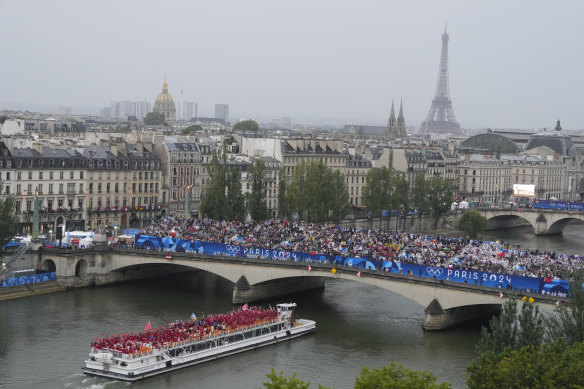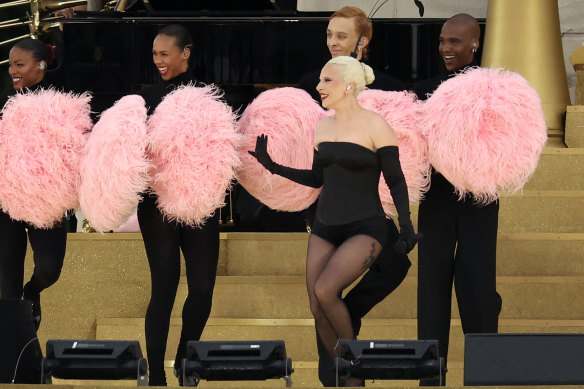This was published 12 months ago
Opinion
A noble failure: The Paris opening ceremony was a creative tour de force, but let athletes down
Ric Birch
Producer and directorIt went on and on but seemed slow to get going: the tricoleur pyro curtain at Austerlitz went off with a bang, and then nothing happened. Finally, a boatload of Greek tourists having an office party appeared under the bridge, and the show began. The traditional Parade of Nations, this time on water, was under way, while the Olympic torch began the final leg of its 2024 journey.
Reviews of the Paris 2024 Olympic opening ceremony range from fawning to outraged, and, indeed, the creative content often seemed intended to be controversial. There’s no doubt it was, at times, incoherent. The chaos only reinforced why there are words in French like mélange, montage, pastiche and collage, none of which explain the ceremony in its entirety.
I saw it as a big-budget French revue, paying homage to every theatrical meme the creators could think of, from Grand Opera to Grand Guignol and Folies Bergère, accompanied by videographers at every step. Unfortunately, this was a ceremony that could not be enjoyed, understood or even seen by a live spectator as it only made sense (sometimes) if you watched the entire spectacle on a screen.
The parade of boats was interminable but bearable on television because of the creative interruptions, apart from the logistical issue of showing the name of each country’s team mostly in English but forming the parade in French alphabetical order. The deluge of rain throughout was either a sign of the Almighty’s displeasure or just one more thing to overcome in the great theatrical tradition of “the show must go on”.
On the river, the boats kept coming while Lady Gaga appeared in a swarm of pompoms and sang very seriously on a golden staircase surrounded by men helping her undress in a choreographic homage to Marilyn Monroe’s Diamonds are a girl’s best friend routine and the set designer added a signpost saying “Paris” in case we thought we were in New York.
It took a while, but eventually, a variety of burlesque acts unfolded on buildings and bridges as the boats moved slowly downstream, their international passengers grinning like gargoyles in the rain and waving national flags like crazy. It was apparent that many of the passengers were far too old to be athletes and that technical staff had been roped in to make up the numbers. National flag bearers, traditionally a post of great honour for an athlete, were completely unidentifiable among the throngs of passengers.

Slowly the boats made their way down the Seine.Credit: Getty Images
”Colourful” seemed to be the order of the day for costume designers, and the menage à trois reference was particularly colourful. From out of nowhere and for no particular reason, we cut to the rooftop of the Grand Palais, where mezzo-soprano Axelle Saint-Cirel was perched on a platform singing the Marseillaise with a couple of French flags nearby. It’s the best anthem in the world, and Saint-Cirel sang as though her heart were breaking for the Republic, whose creative excesses were taking place all around and far below her.
Bizet’s Carmen on a boat, Charles Aznavour references, sway pole performers trying to brain themselves on the pavement or each other, dancers backed with a cloth of gold bravely performing their water dance in a fountain and the rain. Dionysus reclining in the centre of a fruit salad, looking like a blue Smurf sitting on Carmen Miranda’s hat. Skateboarders and BMX bikers doing their best on a wet and slippery stage.
As we neared the end of the alphabet, Australia still hadn’t appeared. Had they missed their boat? No, finally, they appeared in line ahead of the US party barge, with France coming up astern to great applause from the drenched and long-suffering crowds along the Seine. It was the end of the “artistic” part of the ceremony, which had apparently been presented in eight segments, but for the life of me, I couldn’t tell them apart.
In summary: the Paris 2024 opening ceremony was a noble failure, and an element of that failure was the decision to introduce the Olympic athletes to the world on boats motoring down the Seine.

Lady Gaga performs amid a cloud of pom poms.Credit: Getty Images
The athletes are the stars of an Olympic opening ceremony, and they should enter a stadium, the traditional site of sport from the earliest days of the ancient Greek Games, on foot rather than be treated as extras who can be positioned on vessels and paraded past spectators too far away to be visible without telephoto lenses.
Athletes should make their way into a stadium as national teams and gather with all other competitors in a formal assembly appropriate to the serious business ahead. In Paris, they were transported on boats and then delivered to the Trocadero where they just mingled together like tourists on holiday.
If Danny Boyle in London 2012 had put 10,000 athletes into 250 open-top sightseeing buses and driven them past London landmarks and called it the athlete’s parade, there would have been an outcry.
The nobility of Paris’ failure lies in the attempt to devise new ways to energise the opening ceremony while incorporating the Olympic elements but, unfortunately, this was not particularly successful.
I have no issues at all with the creative ideas and artistry of the eight creative segments that preceded the Trocadero stage. They were the legitimate ideas and concepts of a creative team interpreting Paris and France for an Olympic ceremony, and they were collectively a creative tour de force. The failure arises from trying to integrate the parade of athletes and even the national anthem into those same creative elements.
In future, I hope that the IOC understands and respects the difference between the formal elements of an opening ceremony and those parts that celebrate the outpouring of a nation’s most creative individuals and doesn’t try to combine them. By all means, allow tourism authorities to have their landmarks celebrated and displayed to a global audience by staging an artistic introduction in and about a city rather than in a stadium. That is not a problem.
But the IOC should insist that athletes enter a stadium, their rightful environment, to be introduced to the world rather than being treated in the same way as tourists coming to town. They should enter on foot, perpetuating and honouring the way athletes since ancient times have entered a place of competition and are introduced to spectators. And then the formal elements of the ceremony take place, and the Games can begin.
Ric Birch is a producer and director who has been involved in the planning and delivery of opening and closing ceremonies for five Olympics including in Sydney 2000 Games.
Get a weekly wrap of views that will challenge, champion and inform your own. Sign up for our Opinion newsletter.